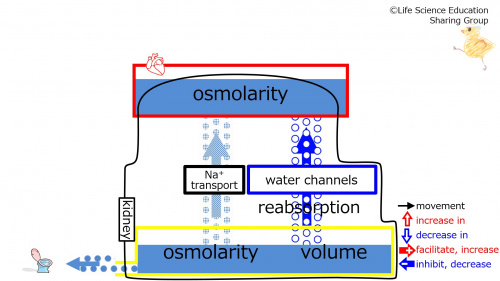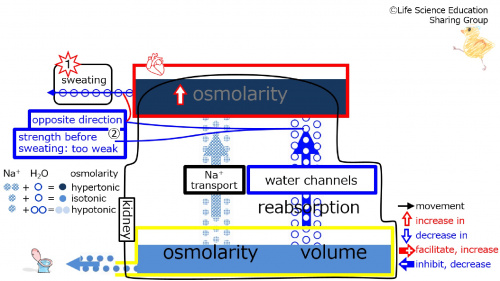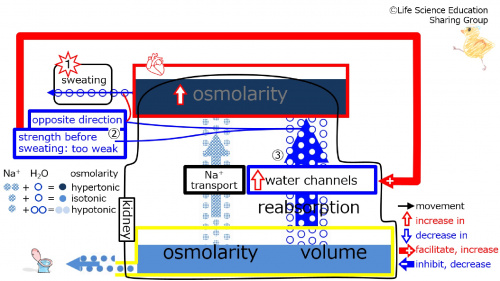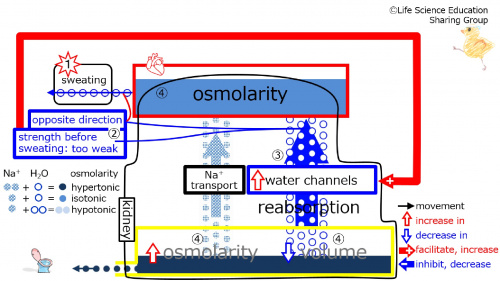「SHolroydAtWeilCornellMedQatar/Urology/Kidney/Tubules/WaterChannels/ControlToSweating」の版間の差分
編集の要約なし |
編集の要約なし |
||
| 1行目: | 1行目: | ||
{{Point|With sweating | {{Point|With sweating the plasma osmolarity increases, and negative feedback increases the number of water channels.発汗により血漿浸透圧が上昇すると、負のフィードバックは、尿細管の水チャンネルを増加させる。 | ||
}} | |||
<!-- | <!-- | ||
| 10行目: | 11行目: | ||
[[メディア:WaterChannelsBaseLine-Eng.mp4|video prior to sweating]]<br> | [[メディア:WaterChannelsBaseLine-Eng.mp4|video prior to sweating]]<br> | ||
--> | --> | ||
Before sweating (at baseline), we will make the assumption that the subject is in homeostasis with adequate strength of the plasma osmolarity-decreasing effect of reabsorption (through the water channels) as well as normal plasma and urine osmolarities (isotonic) and urine volume.発汗前(ベースライン)では恒常性が保たれていて、(水チャンネルを通じての)水分再吸収の血漿浸透圧低下作用は適度な強さであり、血漿浸透圧と尿浸透圧は正常(等張)、尿量も正常であるとしましょう。 | |||
<br style="clear:both;" /> | <br style="clear:both;" /> | ||
</div> | </div> | ||
| 19行目: | 20行目: | ||
[[メディア:WaterChannelsSweating2-Eng.mp4|video just after sweating]]<br> | [[メディア:WaterChannelsSweating2-Eng.mp4|video just after sweating]]<br> | ||
--> | --> | ||
Step 1: With sweating, water leaves the plasma and osmolarity increases ( | Step 1: With sweating, water leaves the plasma and osmolarity increases (concentrated, hypertonic). <br> | ||
<br> | <br> | ||
Step 2: | Step 2: This is in the opposite direction to the plasma osmolarity-decreasing effect of the reabsorption. Thus, although the strength of the plasma osmolarity-decreasing effect of reabsorption (through the water channels) was adequate before sweating (at baseline), this strength is now <font color="#00f">too weak (blue)</font> to reverse the increased plasma osmolarity (concentrated, hypertonic) produced by sweating. Control by negative feedback is needed. 図の①:発汗により水分が血漿から出るため、血漿浸透圧が上昇し(濃く、高張になり)ます。<br> | ||
図の②:これは、(水チャンネルを通じての)水分再吸収の血漿浸透圧低下作用と逆の方向です。そのため、(水チャンネルを通じての)水分再吸収の血漿浸透圧低下作用の強さは、発汗前(ベースライン)では適度でしたが、発汗により上昇した(濃く、高張になった)血漿浸透圧を戻すためにはその強さでは<font color="#00f">不足(青)</font>となります。負のフィードバックによる調節が必要です。 | |||
<br style="clear:both;" /> | <br style="clear:both;" /> | ||
</div> | </div> | ||
| 35行目: | 37行目: | ||
[[メディア:WaterChannelsSweating4-Eng.mp4|video just after the increase in vasopressin (ADH) caused by sweating]]<br> | [[メディア:WaterChannelsSweating4-Eng.mp4|video just after the increase in vasopressin (ADH) caused by sweating]]<br> | ||
--> | --> | ||
Step 3: With the | Step 3: With the strength of the plasma osmolarity-decreasing effect (through the water channels) of the reabsorption before sweating (at baseline) being <font color="#00f">too weak (blue)</font>, the negative feedback <font color="#ff0000">increases (red)</font> the reabsorption of water from the tubule.図の③:(水チャンネルを通じての)水分再吸収の血漿浸透圧低下作用が発汗前(ベースライン)の強さでは<font color="#00f">不足(青)</font>なので、負のフィードバックが水チャンネルを<font color="#ff0000">増加(赤)</font>させます。これにより尿細管からの水分再吸収は増加します。 | ||
< | |||
<br style="clear:both;" /> | <br style="clear:both;" /> | ||
| 45行目: | 45行目: | ||
[[メディア:WaterChannelsSweating5-Eng.mp4|video showing the changes in plasma and urine after the increase in vasopressin (ADH) caused by sweating]]<br> | [[メディア:WaterChannelsSweating5-Eng.mp4|video showing the changes in plasma and urine after the increase in vasopressin (ADH) caused by sweating]]<br> | ||
--> | --> | ||
Step | Step 4: With the increase in water reabsorption, diluted (hypotonic) solution enters the plasma. This will lead to a reverse in the increased plasma osmolarity (concentrated, hypertonic) produced by sweating, decreasing it towards normal (baseline, isotonic) osmolarity. Because diluted (hypotonic) solution leaves the tubule due to reabsorption, the fluid remaining in the tubule has increased osmolarity (concentrated, hypertonic). Also, with the increase in water reabsorption, there is less water remaining in the tubule. Overall, the urine becomes concentrated and decreases in volume.図の④:水分再吸収が増加し、薄い溶液(低張液)が血漿に入ります。発汗により上昇した(濃く、高張になった)血漿浸透圧は、発汗前の正常な(ベースラインの)浸透圧(等張)へ向けて低下します。<br> | ||
再吸収で薄い溶液(低張液)が尿細管から出るため、残る液の浸透圧は上昇し(濃く、高張になり)ます。水分再吸収も増加するため、尿細管に残る水分は減少します。つまり尿は濃く、少量になります。 | |||
<br style="clear:both;" /> | <br style="clear:both;" /> | ||
</div> | </div> | ||
| 53行目: | 54行目: | ||
//LEVEL:2 | //LEVEL:2 | ||
//RAND | //RAND | ||
With sweating | With sweating the plasma osmolarity increases, and negative feedback {~=increases~decreases} the number of water channels.発汗により血漿浸透圧が上昇すると、負のフィードバックは、尿細管の水チャンネルを {=増加~減少}させる 。 | ||
//LEVEL: | //LEVEL:4 | ||
//RAND | //RAND | ||
With sweating, the plasma osmolarity { | With sweating, the plasma osmolarity {~=increases~decreases}. This is in the {~same direction as~=opposite direction to} the plasma {~osmolarity-increasing~=osmolarity-decreasing} effect of the reabsorption from the tubule. The negative feedback {~=increases~decreases} the water reabsoption (through the water channels) from the tubule. Urine volume will {~increase~=decrease}, while urine osmolarity will {~=increase~decrease}. This will {~increase~=decrease} plasma osmolarity returning to normal (baseline). 発汗により血漿浸透圧は {=上昇~低下}する。これは、腎臓/尿細管からの(水チャンネルを通じての)水分再吸収の血漿浸透圧{~上昇~=低下}作用と {~同じ~=逆の}方向であり、負のフィードバックは、尿細管の水チャンネルを {=増加~減少}させ、水分再吸収を {=増加~減少}させる。これは尿量を {~増加~=減少}させ、尿浸透圧を {~=上昇~低下}させ、血漿浸透圧を(等張へ向けて) {~上昇~=低下}させる。 | ||
</GIFT> | </GIFT> | ||
2020年3月16日 (月) 17:38時点における版
| With sweating the plasma osmolarity increases, and negative feedback increases the number of water channels.発汗により血漿浸透圧が上昇すると、負のフィードバックは、尿細管の水チャンネルを増加させる。 |
Before sweating (at baseline), we will make the assumption that the subject is in homeostasis with adequate strength of the plasma osmolarity-decreasing effect of reabsorption (through the water channels) as well as normal plasma and urine osmolarities (isotonic) and urine volume.発汗前(ベースライン)では恒常性が保たれていて、(水チャンネルを通じての)水分再吸収の血漿浸透圧低下作用は適度な強さであり、血漿浸透圧と尿浸透圧は正常(等張)、尿量も正常であるとしましょう。
Step 1: With sweating, water leaves the plasma and osmolarity increases (concentrated, hypertonic).
Step 2: This is in the opposite direction to the plasma osmolarity-decreasing effect of the reabsorption. Thus, although the strength of the plasma osmolarity-decreasing effect of reabsorption (through the water channels) was adequate before sweating (at baseline), this strength is now too weak (blue) to reverse the increased plasma osmolarity (concentrated, hypertonic) produced by sweating. Control by negative feedback is needed. 図の①:発汗により水分が血漿から出るため、血漿浸透圧が上昇し(濃く、高張になり)ます。
図の②:これは、(水チャンネルを通じての)水分再吸収の血漿浸透圧低下作用と逆の方向です。そのため、(水チャンネルを通じての)水分再吸収の血漿浸透圧低下作用の強さは、発汗前(ベースライン)では適度でしたが、発汗により上昇した(濃く、高張になった)血漿浸透圧を戻すためにはその強さでは不足(青)となります。負のフィードバックによる調節が必要です。
Step 3: With the strength of the plasma osmolarity-decreasing effect (through the water channels) of the reabsorption before sweating (at baseline) being too weak (blue), the negative feedback increases (red) the reabsorption of water from the tubule.図の③:(水チャンネルを通じての)水分再吸収の血漿浸透圧低下作用が発汗前(ベースライン)の強さでは不足(青)なので、負のフィードバックが水チャンネルを増加(赤)させます。これにより尿細管からの水分再吸収は増加します。
Step 4: With the increase in water reabsorption, diluted (hypotonic) solution enters the plasma. This will lead to a reverse in the increased plasma osmolarity (concentrated, hypertonic) produced by sweating, decreasing it towards normal (baseline, isotonic) osmolarity. Because diluted (hypotonic) solution leaves the tubule due to reabsorption, the fluid remaining in the tubule has increased osmolarity (concentrated, hypertonic). Also, with the increase in water reabsorption, there is less water remaining in the tubule. Overall, the urine becomes concentrated and decreases in volume.図の④:水分再吸収が増加し、薄い溶液(低張液)が血漿に入ります。発汗により上昇した(濃く、高張になった)血漿浸透圧は、発汗前の正常な(ベースラインの)浸透圧(等張)へ向けて低下します。
再吸収で薄い溶液(低張液)が尿細管から出るため、残る液の浸透圧は上昇し(濃く、高張になり)ます。水分再吸収も増加するため、尿細管に残る水分は減少します。つまり尿は濃く、少量になります。
Challenge Quiz
With sweating the plasma osmolarity increases, and negative feedback increases decreases the number of water channels.発汗により血漿浸透圧が上昇すると、負のフィードバックは、尿細管の水チャンネルを 増加 減少 させる 。
With sweating, the plasma osmolarity increases decreases . This is in the same direction as opposite direction to the plasma osmolarity-increasing osmolarity-decreasing effect of the reabsorption from the tubule. The negative feedback increases decreases the water reabsoption (through the water channels) from the tubule. Urine volume will increase decrease , while urine osmolarity will increase decrease . This will increase decrease plasma osmolarity returning to normal (baseline). 発汗により血漿浸透圧は 上昇 低下 する。これは、腎臓/尿細管からの(水チャンネルを通じての)水分再吸収の血漿浸透圧 上昇 低下 作用と 同じ 逆の 方向であり、負のフィードバックは、尿細管の水チャンネルを 増加 減少 させ、水分再吸収を 増加 減少 させる。これは尿量を 増加 減少 させ、尿浸透圧を 上昇 低下 させ、血漿浸透圧を(等張へ向けて) 上昇 低下 させる。




